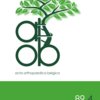Are C-reactive protein (CRP) and neutrophil to lymphocyte ratio (NLR) predictive markers of successful two-stage prosthetic joint infection management?
Published online: Jan 08 2024
Abstract
The treatment of prosthetic joint infections (PJI) regularly involves a two-stage surgical strategy. The second stage is generally performed when the surgeon estimates that the infection is under control based on either the treatment length or clinical and biological data. We have raised the question whether standardization of C-reactive protein (CRP) and neutrophil to lymphocyte ratio (NLR) values could be either indicative of infection control or predictive of infection recurrence.
This was an analytical retrospective and monocentric cross-sectional observational study. The CRP and NLR values were recorded prior to the second-stage surgery in a sample of 100 patients who underwent a two-stage revision arthroplasty following a PJI, and these values were correlated with the absence of infectious recurrence within a 2-year follow-up.
The statistical analysis consisted of evaluating the diagnostic validity of each marker, first individually, and then in combination.
CRP was shown associated with a 68% sensitivity, 40% specificity, 27% positive predictive value (PPV), and 79% negative predictive value (NPV). The ROC curve was 51.1%. The NLR displayed a 12% sensitivity, 89% specificity, 27% PPV, and 75% NPV. The ROC curve was 47.9%. The combination of the two markers did not fundamentally improve the statistical results, with only a 43% concordance of the two markers, 27% sensitivity, 84% specificity, 37% PPV, and 77% NPV.
Measuring CRP and NLR values, either individually or in combination, before the second-stage revision arthroplasty did not turn out to be predictive of either infection recurrence or cure within two years of follow-up. Therefore, an absolute test is still lacking, which would enable us to predict without failure the absence of control or the control of a PJI before or after second-stage revision.
Level of evidence: Level III, retrospective cross-sectional study.
